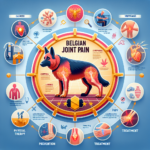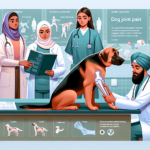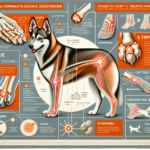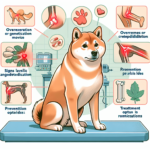Scottish Deerhound Joint Pain: Causes, Symptoms, Prevention, and Treatment
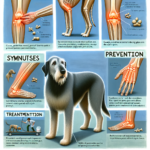
Introduction
The Scottish Deerhound, often referred to as the “Royal Dog of Scotland,” is a majestic and ancient breed known for its grace, speed, and gentle demeanor. Originating from Scotland, these dogs were historically used by nobility for hunting deer, which is reflected in their name. With a tall, lean build and a wiry coat, the Scottish Deerhound is not only a sight to behold but also a loyal and affectionate companion.
Like many large breeds, the Scottish Deerhound is prone to certain health issues, with joint pain being a significant concern. Understanding the causes, symptoms, prevention, and treatment of joint pain in this breed is crucial for ensuring their well-being and longevity.
Joint health is particularly important for the Scottish Deerhound due to their size and active nature. Proper joint care can help prevent debilitating conditions that can severely impact their quality of life. This article will delve into the various aspects of joint pain in Scottish Deerhounds, providing comprehensive information for owners and enthusiasts.
Breed-Specific Joint Pain Risks
Genetic Predisposition
Scottish Deerhounds are genetically predisposed to several joint-related issues, including hip dysplasia, elbow dysplasia, and arthritis. Hip dysplasia, a condition where the hip joint doesn’t fit properly into the hip socket, is particularly common in large breeds like the Deerhound. This genetic predisposition can lead to early onset of joint pain and mobility issues.
Age-Related Risks
As Scottish Deerhounds age, the risk of developing joint pain increases. Typically, signs of joint issues may start to appear in middle age, around 5 to 7 years old. However, due to their genetic predisposition, some Deerhounds may exhibit symptoms earlier. It’s essential to monitor their joint health closely as they age to catch any issues early.
Activity Level and Joint Stress
Scottish Deerhounds are known for their high energy levels and need for regular exercise. While this activity is beneficial for their overall health, it can also contribute to joint stress, especially if not managed properly. Activities like running, jumping, and playing can put additional strain on their joints, potentially exacerbating any underlying issues.
Common Symptoms of Joint Pain in Scottish Deerhounds
General Symptoms
- Limping or favoring one leg
- Stiffness, especially after rest
- Reluctance to move or climb stairs
- Decreased activity or playfulness
- Swelling around the joints
- Whining or showing signs of discomfort when touched
Breed-Specific Symptoms
In Scottish Deerhounds, joint pain may manifest more prominently due to their size and build. Owners may notice a pronounced limp or stiffness, particularly in the hind legs. Additionally, due to their deep-chested structure, any changes in gait or posture can be more noticeable.
When to Consult a Vet
If you observe any of the above symptoms in your Scottish Deerhound, it’s crucial to consult a veterinarian promptly. Early intervention can help manage the condition more effectively and prevent further deterioration. Regular veterinary check-ups are also essential for monitoring joint health and catching any issues early.
Preventive Measures for Joint Health
Exercise Recommendations
Maintaining an appropriate exercise routine is vital for the joint health of Scottish Deerhounds. Low-impact activities such as walking and swimming are excellent choices. These exercises help keep the joints mobile without putting excessive strain on them. Avoid high-impact activities like jumping or running on hard surfaces, which can exacerbate joint stress.
Dietary Suggestions
A balanced diet rich in essential nutrients can support joint health. Consider incorporating foods or supplements that contain glucosamine, chondroitin, and omega-3 fatty acids. These nutrients help maintain cartilage health and reduce inflammation. Always consult your veterinarian before adding any supplements to your dog’s diet.
Weight Management
Maintaining a healthy weight is crucial for reducing joint stress in Scottish Deerhounds. Excess weight can put additional pressure on the joints, exacerbating pain and discomfort. Regular exercise and a balanced diet are key to keeping your Deerhound at an optimal weight. Consult your veterinarian for specific weight management guidelines tailored to your dog.
Early Screening and Monitoring
Early screening for joint issues can help catch problems before they become severe. Regular veterinary check-ups should include joint assessments, especially as your Deerhound ages. X-rays and other diagnostic tools can help identify early signs of joint problems, allowing for timely intervention.
Treatment Options for Joint Pain
Non-Surgical Treatments
Non-surgical treatments for joint pain in Scottish Deerhounds include medications, physical therapy, and lifestyle adjustments. Anti-inflammatory medications and pain relievers can help manage symptoms. Physical therapy, including exercises and massages, can improve joint mobility and reduce pain. Lifestyle adjustments, such as providing a comfortable bed and avoiding strenuous activities, can also help.
Surgical Options
In severe cases, surgical intervention may be necessary. Common surgeries for joint pain include hip replacement, arthroscopy, and joint fusion. These procedures can significantly improve the quality of life for Deerhounds suffering from severe joint pain. Consult with a veterinary orthopedic specialist to determine the best surgical option for your dog.
Alternative Therapies
Alternative therapies such as acupuncture, hydrotherapy, and massage can also benefit Scottish Deerhounds with joint pain. Acupuncture can help reduce pain and inflammation, while hydrotherapy provides low-impact exercise that strengthens muscles without stressing the joints. Regular massages can improve circulation and reduce muscle tension around the joints.
Lifestyle and Management Tips
Daily Care Routine
A daily care routine for managing joint pain in Scottish Deerhounds should include gentle exercise, a balanced diet, and regular monitoring of symptoms. Start the day with a short walk to keep the joints mobile, followed by a nutritious meal that supports joint health. Incorporate rest periods throughout the day to prevent overexertion.
Modifying the Home Environment
Making your home more comfortable for a dog with joint pain can significantly improve their quality of life. Consider adding ramps to help them navigate stairs and providing orthopedic beds for better joint support. Ensure that their living area is free of slippery surfaces to prevent falls and injuries.
Long-Term Management
Long-term management of joint pain in Scottish Deerhounds involves regular veterinary check-ups, consistent exercise, and a supportive diet. Monitoring their weight and adjusting their activity level as needed can help manage symptoms. Stay vigilant for any changes in behavior or mobility, and consult your veterinarian for ongoing care recommendations.
FAQs About Scottish Deerhounds and Joint Pain
What are the early signs of joint pain in Scottish Deerhounds?
Early signs of joint pain include limping, stiffness, reluctance to move, and decreased activity levels. If you notice any of these symptoms, consult your veterinarian promptly.
Can joint pain in Scottish Deerhounds be prevented?
While genetic predisposition cannot be entirely prevented, maintaining a healthy weight, providing appropriate exercise, and ensuring a balanced diet can help reduce the risk of joint pain.
Are there specific supplements that can help with joint health?
Yes, supplements containing glucosamine, chondroitin, and omega-3 fatty acids can support joint health. Always consult your veterinarian before adding any supplements to your dog’s diet.
When should I consider surgical options for my dog’s joint pain?
Surgical options should be considered when non-surgical treatments are no longer effective, and your dog’s quality of life is significantly impacted. Consult with a veterinary orthopedic specialist to determine the best course of action.
How often should I take my Scottish Deerhound to the vet for joint health check-ups?
Regular veterinary check-ups are essential, especially as your Deerhound ages. Annual check-ups are recommended, but more frequent visits may be necessary if your dog shows signs of joint pain.
Conclusion
Joint pain is a significant concern for Scottish Deerhounds, given their genetic predisposition and active nature. By understanding the causes, symptoms, prevention, and treatment options, owners can take proactive steps to ensure their Deerhound’s joint health. Regular veterinary check-ups, a balanced diet, appropriate exercise, and early intervention are key to managing joint pain effectively. By taking these measures, you can help your Scottish Deerhound lead a happy, active, and pain-free life.

